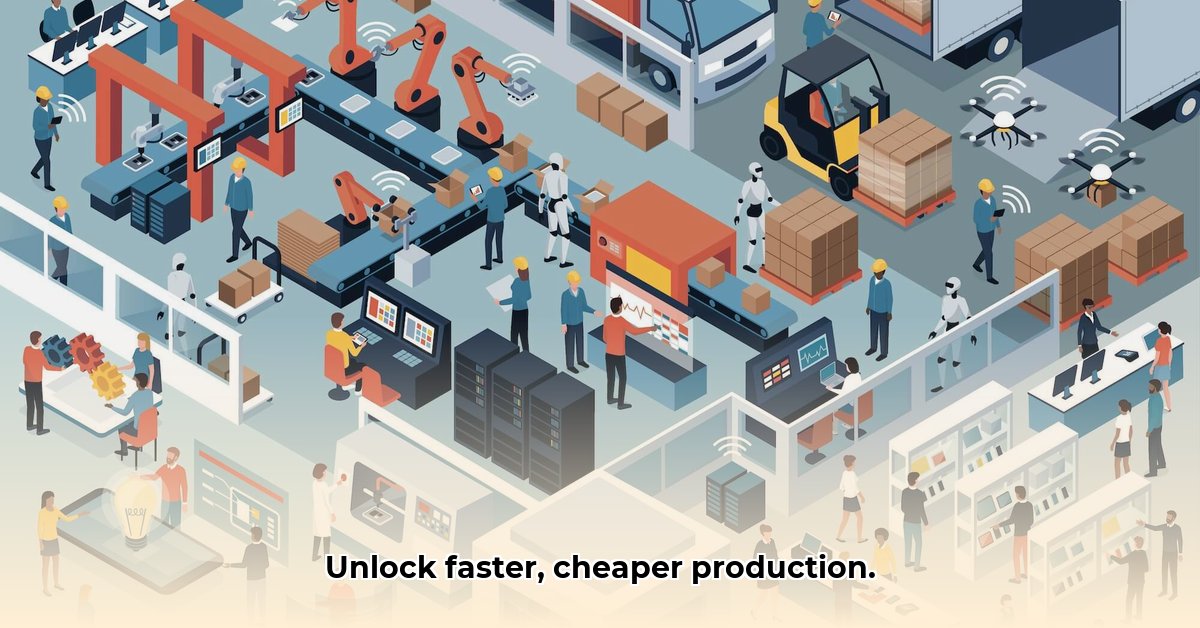# Supercharge Your Automated Production Systems: A Comprehensive Guide
Automating your production processes can revolutionize your business, significantly boosting efficiency and profitability. However, with a vast array of options available, navigating the landscape of automated production systems can feel daunting. This comprehensive guide simplifies the complexities, providing you with the knowledge to make informed decisions, regardless of your business size or industry.
## The Rise of Automated Production Systems: Driving Efficiency and Innovation
The demand for automated production systems is surging, fueled by the imperative to enhance output, minimize operational expenditures, and elevate overall efficiency. This demand is driving rapid innovation across automation technologies, from specialized machinery designed for large-scale production to highly adaptable systems capable of handling diverse tasks. Selecting the optimal automation system for your specific needs is paramount to achieving success, streamlining workflows, and maximizing precision.
### Selecting the Right Automation Solution for Your Business Needs
The ideal automation technology hinges on your unique operational requirements and goals. Here's a detailed overview of the primary types:
* **Fixed Automation:** Best suited for high-volume production of identical products, offering unparalleled efficiency but limited flexibility. Think of an automotive assembly line: highly efficient for producing the same model repeatedly but requires substantial modifications for even minor changes.
* **Programmable Automation:** Provides greater versatility through computer programs (PLCs) that precisely control actions. This offers increased flexibility compared to fixed automation but still has limitations and requires a sizeable initial capital investment.
* **Flexible Automation:** Designed for manufacturing various products in smaller quantities, offering exceptional adaptability and swift changeover capabilities. Envision a highly versatile workforce capable of transitioning between different tasks with ease. Initial setup can be costly and complex.
* **Integrated Automation:** Combines multiple automation technologies to create a seamless workflow from raw materials to finished goods, providing maximum control and efficiency. This requires a significant upfront investment, extensive detailed planning, and specialized expertise.
* **Process Automation:** Targets the automation of specific tasks within your production flow, such as quality inspections or material handling, improving efficiency in targeted areas without requiring massive investment.
### Strategic Implementation: Making Your Automation Investment Pay Off
Successfully integrating automation into your existing processes necessitates a well-defined strategic plan. Addressing this across different stakeholder groups, focusing on training and safety is critical:
| Stakeholder | Short-Term Goals | Long-Term Vision |
| :----------------------------- | :----------------------------------------------------------------------------------------------------------------------------------- | :-------------------------------------------------------------------------------------------------------------------------------------------------------------------------------------------------------------------------------- |
| **Small & Medium Businesses (SMEs)** | Conduct a thorough needs assessment. Explore modular systems that can scale with your business growth plan. | Train your staff to effectively operate and maintain new systems. Implement data analytics to optimize processes on an ongoing basis. |
| **Large Manufacturers** | Optimize existing production lines. Pilot test integrated automation solutions on a smaller scale before full implementation. | Establish standard operating procedures for automated systems. Utilize AI to enhance efficiency and implement predictive maintenance protocols. |
| **Automation Providers** | Expand service offerings. Develop customized solutions tailored to specific client needs. | Integrate AI and machine learning (ML) capabilities into product offerings. Develop proactive systems that preemptively identify and resolve issues. |
| **Policy Makers** | Support worker training programs to facilitate adaptation to new technologies. Strengthen safety regulations to address evolving concerns. | Foster collaboration between industry and research institutions. Invest in cutting-edge automation research and development initiatives. |
### Navigating Challenges: Addressing Risks and Uncertainties
While automation offers considerable advantages, it also presents challenges. Comprehensive data is still needed to fully evaluate the return on investment (ROI) for various automation types across different industries. Compliance with existing and evolving regulations is paramount. Security measures must be robust to protect against cyber threats.
### The Bottom Line: Embracing Automation for Future Growth
Automated production systems provide significant opportunities to enhance profitability and boost efficiency. Success hinges on careful planning and strategic execution. Stay informed about emerging trends and adapt your strategies accordingly. Embrace automation to secure a competitive edge in the evolving manufacturing landscape.
## Maximizing ROI: A Deep Dive into Automated Production Systems
**Key Takeaways:**
* The return on investment (ROI) for industrial automation extends beyond mere cost reduction. It encompasses improvements in quality, safety, and delivery times, ultimately enhancing operational flexibility, minimizing waste, and elevating product quality.
* Successful automation implementation demands meticulous planning, phased deployment, and collaboration with a reliable integration partner.
* While rapid returns (1-2 years) are achievable through labor cost savings, long-term value is derived from enhanced efficiency and adaptability.
* The ROI varies depending on the specific automation system implemented. Automating repetitive tasks typically yields faster and more predictable returns.
* Investing in adaptable, scalable equipment ensures your system evolves alongside your business, sustaining long-term ROI.
### Understanding the Full Spectrum of ROI
Calculating the ROI of automation necessitates a holistic understanding of all benefits, including indirect advantages such as reduced waste, enhanced safety, and improved product quality. This comprehensive approach maximizes your return on invested capital. What critical factors should you consider when evaluating ROI?
### Establishing Clear Metrics for Accurate Assessment
Prior to selecting specific automation options, establish clear, measurable metrics or key performance indicators (KPIs). Are your primary objectives to reduce operational costs, increase throughput through automated processes, or minimize defects to improve product quality? These objectives will guide you towards the most effective automation solutions to maximize your return on investment.
### Direct vs. Indirect Costs: A Comprehensive Analysis
Calculating ROI involves more than simply subtracting initial investment from immediate savings. Direct costs include equipment purchase, installation, and ongoing maintenance, while indirect costs encompass reduced waste, improved product quality, and enhanced worker safety. Evaluate the broader impact to your bottom line.
### System-Specific ROI: Tailoring Automation to Maximize Returns
The ROI is highly dependent on the specific automated systems chosen, ranging from simple robotic arms to advanced AI-powered systems and fully integrated production lines. Optimize processes with iterative improvements made through careful calculation and potentially a phased implementation strategy.
### The Importance of Scalability and Flexibility
Opting for a scalable system that can expand with your business growth is essential. A modular system allows for effortless expansion while maintaining the capacity to adapt to evolving market demands and new product lines.
### A Phased Deployment Strategy
Adopting a phased approach allows for iterative improvements, minimizing risk and distributing investment costs over time. Begin with a pilot project targeting a high-impact area, test and refine the solution, and then strategically scale your automation strategy.
### Choosing the Right Integration Partner
Selecting a capable automation partner is paramount for ensuring success and maximizing ROI. Their expertise in project management, technical support, and after-sales service directly influences the performance and longevity of your automated system.
## Future-Proofing Manufacturing: Embracing Advanced Automation Technologies
**Key Takeaways:**
* Smart manufacturing, powered by automation, promises improved efficiency and productivity but presents inherent challenges.
* Strategic planning is vital for successful implementation, encompassing phased approaches and effective workforce integration.
* Advanced technologies like AI and IoT offer immense potential but necessitate careful attention to security considerations.
* Smaller manufacturers can leverage flexible automation and government assistance to remain competitive.
* Collaboration among manufacturers, technology providers, and policymakers is essential for building a thriving future for manufacturing.
### The Power of Automation
Automation extends beyond robots; it encompasses the integration of robotics, AI, the Internet of Things (IoT), and predictive maintenance to create a smarter, more efficient factory. Are you ready to leverage these advanced systems to enhance your manufacturing operations?
The benefits include increased output, reduced errors, lower costs, and greater flexibility. Studies indicate potential productivity improvements of 10-20%. However, it is crucial to recognize that successful implementation requires expertise.
### Navigating the Implementation
Implementing smart manufacturing requires substantial upfront investment. Adopting a phased approach, starting with high-impact areas, can mitigate risk. Explore government grants and incentives to alleviate financial burdens. Ensuring seamless integration of different systems can be complex.
### The Human Element: Training and Adaptation
Retraining your employees to manage and maintain advanced systems is critical for a successful transition. This investment builds a workforce prepared for the future.
### Prioritizing Security
With growing reliance on cloud computing and networked systems, robust security protocols are essential. Consider this as safeguarding a valuable asset, where prevention is more effective than remediation.
### A Simplified Strategy for Manufacturers of All Sizes:
1. **Assessment:** Analyze current operations, identify bottlenecks, and pinpoint automation opportunities for reducing overhead.
2. **Planning:** Develop a phased implementation plan. Begin with a pilot project to validate the concept, and then scale accordingly.
3. **Technology Selection:** Opt for user-friendly, easily integrable automation technologies, prioritizing scalability.
4. **Training:** Invest in comprehensive workforce training programs.
5. **Security Implementation:** Implement robust cybersecurity measures from the outset.
### Envisioning the Future
The future of manufacturing is about embracing change, investing wisely, and adapting strategically. The convergence of smart technologies, efficient processes, and human-centric design will define the future of manufacturing.
Latest posts by Lola Sofia (see all)
















